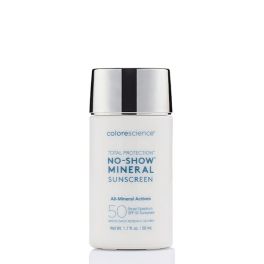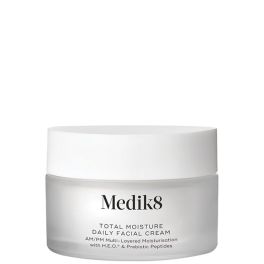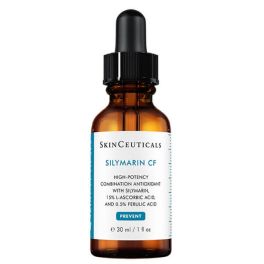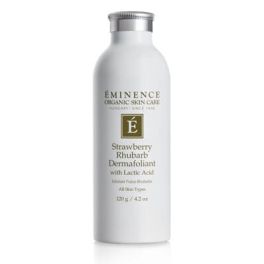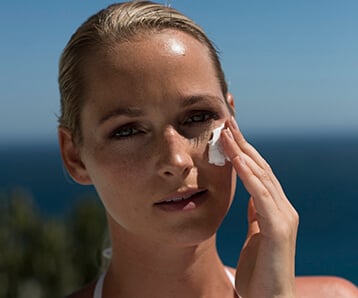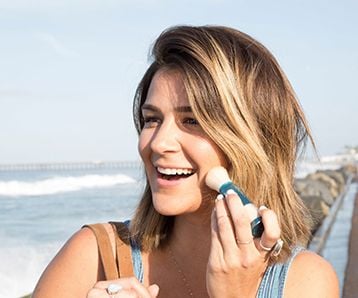11 Reasons to Stay Out of the Sun by Jan Marini Posted on 25 Jul 2011
11 Reasons to Stay Out of the Sun
By Jan Marini
Most people don’t realise that approximately 90–95 percent of what we perceive as inevitable ageing is caused by sun exposure. Sunscreen is the most effective skin care product that prevents the outward signs of aging. As the occurrence of dangerous skin cancers continues to rise, there is overwhelming data that supports consistent sunscreen use.
Following are the 11 reasons why you should protect yourself from the harmful effects of the sun. Remember, achieving a youthful appearance is as easy as, well, sunscreen!
Reason 1
When you look in the mirror at those first fine lines, coarsening texture, sallow tones and uneven pigmentation, you may think they are unavoidable. Not so! As much as 90–95 percent of what we consider “inevitable aging” is actually sun damage. Most of this damage occurs before the age of 10, and at least 80 percent of it takes place before the age of 18. However, it can take up to 30 years for this damage to finally become evident.
Although wrinkled, sun damaged skin is cosmetically undesirable, the outer damage is also representative of the decreased normal functions of the skin. These include the inability to retain water, compromised immune function, increased sensitivity, reduction of active sweat glands, delayed healing, and changes in pigment cells, just to name a few.
Reason 2
In 1935, approximately one out of 1,500 people in the U.S. were diagnosed with malignant melanoma - the most deadly form of skin cancer. Today, that number has jumped.
Tanning did not become fashionable until Coco Chanel traveled to the French Riviera in the 1920s and returned home with a deep suntan. So it has been less than 100 years that we have chosen to drastically increase our sun exposure - an obvious reason for the prevalence in deadly skin cancer. While some malignant melanoma cases are simply genetic, the remainder is influenced by sun exposure. In fact, the risk of developing malignant melanoma is mainly due to extreme exposure to the sun, including sunburns before the age of 10.
Reason 3
Rosacea is a skin disease of vassal motor instability that is primarily characterized by persistent facial redness and enlarged capillaries known as Telangiectasia. As the disease progresses, sufferers may also experience lesions that mimic acne, along with a host of other unsightly and disfiguring attributes.
Rosacea now affects approximately 13 million Americans and the numbers are growing rapidly. While the specific cause of rosacea is unknown, it has been established that one of the primary causative factors is sun exposure. The average age of onset for rosacea is between 30 and 50. However, this is another psychologically damaging and often embarrassing skin condition that can be prevented.
Reason 4
If you thought cataracts were primarily an inevitable aspect of growing old, think again. Cataracts occur when an ocular opacity partially or completely obscures vision in one or both eyes, resulting in impaired vision or even complete blindness.
While there are a number of conditions and diseases that can contribute to, or cause cataracts, cumulative sun exposure is (once again) a major causative or exacerbating factor in age-related cataracts.
Reason 5
We seldom hear of people dying from the more common melanoma skin cancers such as Basal Cell Carcinoma or Squamous Cell Carcinoma. Basal cell cancers are usually slow growing, while Squamous cell cancers are far more aggressive and can metastasize.
In some cases, skin cancer can be easily and superficially removed. But in many instances, these cancers can substantially reach beyond the superficial borders, necessitating invasive and disfiguring surgical removal. The risk for developing these types of skin cancers increases after years of cumulative sun exposure.
Reason 6
While skin cancer is one of the worst villains, Actinic Keratosis, or precancerous lesions, is also harmful. Actinic Keratosis may appear as unsightly reddish or yellowish brown spots, and may be raised or scaly in texture. Because these lesions are a precursor to skin cancer, they necessitate aggressive treatment, which can be highly effective and prevent the precancerous areas from progressing. Nevertheless, prevention is the better choice.
Reason 7
Solar Lentigines are brown-pigmented areas that can be found on the face, hands and other areas that are exposed to the sun. They are commonly referred to as age spots or liver spots. Usually, Solar Lentigines appear post sunburn, or in older people who have experienced years of chronic sun exposure.
Solar Lentigines can be removed through various methods, but they are cosmetically undesirable and can be prevented by simply wearing sunscreen.
Reason 8
A common misconception is that the sun assists in clearing up acne. Because sun exposure hardens the outer layers of the skin, eruptions may be temporarily suppressed. However, sun exposure stimulates greater oil production, which in turn, provides more fuel for bacteria. When an individual lessens the time spent sunbathing, he or she may experience a major acne flareup. As the outer layer of skin softens, the retentive material rapidly surfaces, resulting in a worsening of the condition.
Reason 9
Oftentimes, unsightly discolorations are left behind once an acne lesion clears up. Referred to as flat macular pigmentation or post-inflammatory hyperpigmentation, these marks are usually reddish, purplish or brownish. Additionally, they are difficult to resolve, and sun exposure makes them darker and more resistant to treatment.
Reason 10
Hair is also vulnerable to the sun. Cumulative sun exposure can cause hair to become dull looking and brittle to the touch. Technically, the sun causes photooxidative splitting of cystine linkages and initializes the formation of free radicals that are detrimental to the protein matrix.
The sun also ages hair by removing its color. Like skin, lighter colored hair with less color pigment is more vulnerable than darker hair with more pigment. Hair products with UV protecting agents are beneficial, but it’s even better to wear a hat.
Reason 11
It is hard to believe that tanning beds were once touted as a safe alternative to outdoor sun exposure. In recent years, numerous medical studies have proven that tanning beds are equally, if not more harmful than natural sunlight.
Most indoor tanning sources emit as much as 95 percent of UVA rays (as opposed to UVB rays). UVA radiation penetrates more deeply into the skin, and the remaining light is UVB, which affects the uppermost layers of skin and is often associated with sunburn. Because there is less superficial burning with tanning beds, there is a false sense that indoor tanning is less harmful.
According to Elizabeth Whitmore, M.D., associate professor of dermatology at Johns Hopkins University School of Medicine, indoor tanning light can – and does – lead to skin cancer and should be avoided.
Look Better, Live Healthier
While youthful, healthy looking skin is greatly desirable, we mustn’t forget that sun protection is not just a cosmetic issue - it’s a serious health issue. Wear your sun protection... and wear it daily!













